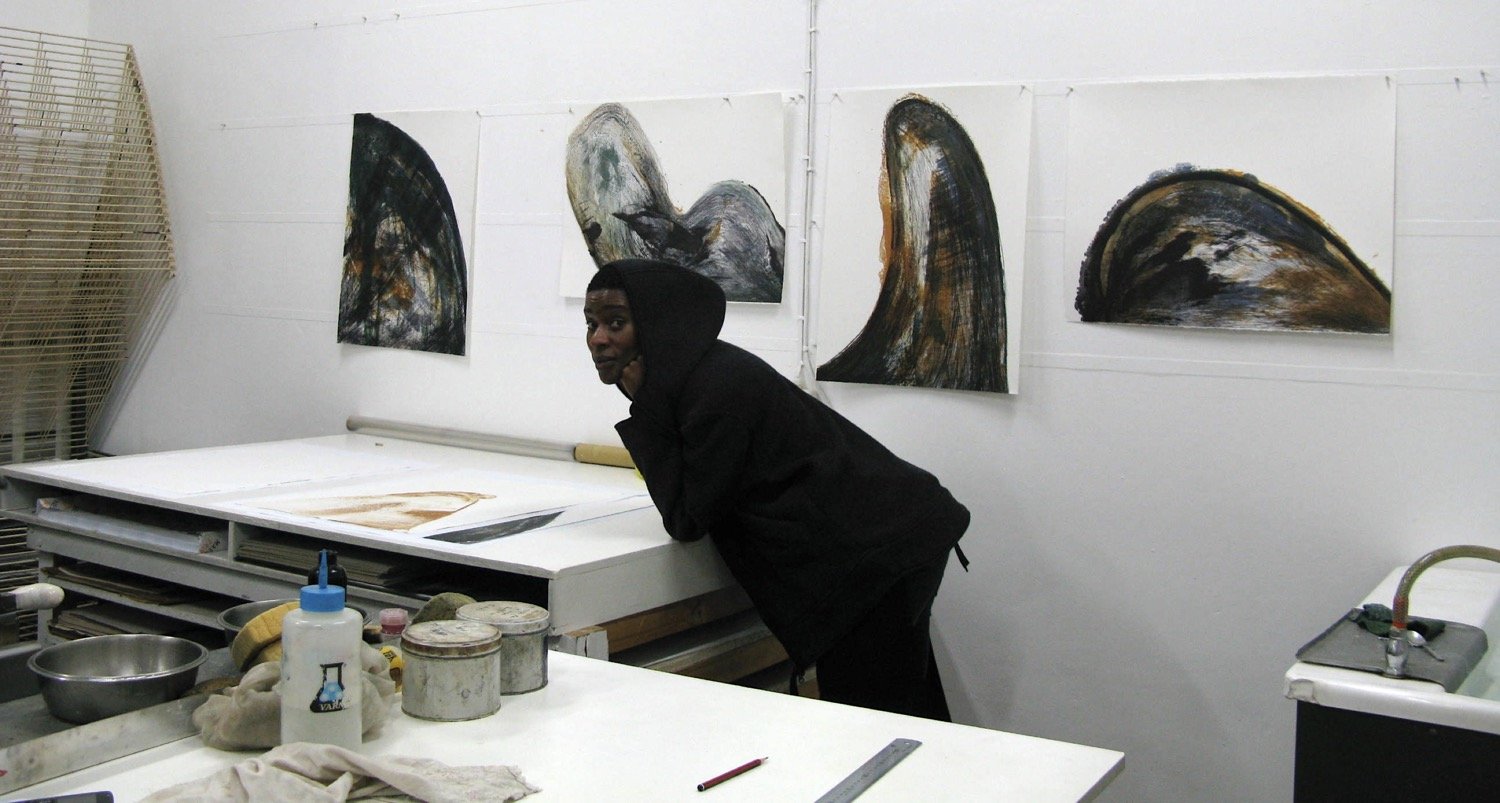Kathryn Smith Archive
The lithographs on this page were published by The Artists' Press and have been archived. For purchase enquiries please contact us.
Kathryn Smith is a interdisciplinary visual artist who is also a qualified forensic artist. Her interest in forensic pathology and psychology led to the creation of these prints which offer strong social commentary to those who wish to delve beyond the surface veneer of celebrities such as Marilyn Monroe.
The result was a suite of ten prints which toured the country as part of
Smith's exhibition as the Standard Bank Young Artist of the Year award
in 2004.
Peculiar Modern Behaviour, or, don't go away, it gets better.
"I have been preoccupied with 'forensic' methods of observation and perception for many years. Much of my work requires viewers to take on the persona of a kind of detective, deconstructing and unravelling clues and references that may not announce themselves outright. These clues are invested in the subject matter and iconography I employ but also live firmly in the media in which I choose to work.
I majored in printmaking during my undergraduate studies but until producing this series with Mark Attwood, I had not made traditional prints for some years. I was looking for ways in which to translate video images, specifically digital screenshots from films whether contemporary, classic or cult, into an 'analogue' form where human labour is evident in the construction of the image.
When working through ideas, I don't draw; I make collages. These can be visual, or more often they take the form of bits of conversations, observations and sampled words from pretty much anywhere. For this series, we decided to experiment with exposing photo-based images onto polymer plates, effecting a photogravure process, but combining this with a photolitho process.
Working with films in this way was very interesting, considering that they were originally shot on film, processed and printed, and now transferred onto VHS or digitized onto DVD for home consumption. This process underwent a curious inversion in this work, as I photographed countless frames off my laptop screen as the DVD played.
Watching films is no longer an exclusively public experience in cinemas. With the kinds of technologies available today, I am able to indulge my interests in capturing what lies beyond the between frames in films at my leisure, in my private space. These 'autopsied' images seem to give rise to other hidden, secret narratives when characters are caught in freeze-frame, or in the background, apparently unnoticed when not taking centre stage.
Located in the realm of creative detection, my work probes issues of truth and evidence, and especially, what constitutes the 'real'. Movies are interesting as they represent what is the absolute opposite of the truth, even when they claim to be 'based on a true story'. Because of their alleged proximity to the 'real', I am drawn to methods of representation that involve photography and reproduction in all possible permutations.
The printmaking process for me is all about seriality - the ability to reproduce, copy, and repeat systematically. I like to think of it as a kind of failed forgery; failed as there really was no 'original' to begin with, just the possibility of many of the same.
This has manifested in other forms of doubling in my work - impersonators and impostors (the latter has a more criminal overtone), body-doubles, lookalikes, masquerading - these all converge at the doorstep of 'identity', dealing principally with surface so much so that the inversion of pure surface to immeasurable depth becomes possible.
I came to Marilyn Monroe through reading Joyce Carol Oates' 'fictional biography' (a paradox in itself) of the tragic figure, called Blonde. Having just completed a series of photographs called Me and My Shadows, where I collaborated with a group of Rat Pack impersonators from Las Vegas, the tenuous but undeniable link between Rat Packer Frank Sinatra, Marilyn, the Mafia and US intelligence seemed ripe to pursue. A quick scan of the FBI documentation on Marilyn quickly brings to mind current US preoccupations with rooting out those who might prove a threat - to what we are still unsure.
Monroe strikes me as being the quintessential symptom of modern society; displaced, alienated, capable of (and required to) taking on a range of personae without a basis in the understanding of self and agency. On another level, her story is also the iconic intersection of celebrity, causality and death, not to mention conspiracy. For someone whose identity is inextricably tied to her image and nothing more, it seemed right to recast her with a host of screen characters that more accurately reflected on her private experiences rather than her public persona.
Like other recent work that co-opts and reinterprets the legacies of the figure of Jack the Ripper, less a real person that a genre in itself, Peculiar Modern Behavior is less about Marilyn and more about musings on the symptoms and conditions of a zeitgeist that more often that not, seems rather pathological."
Kathryn Smith, 2004
New Editions
For orders (with free shipping) or any other enquiries, please contact us.
Peculiar Modern Behaviour
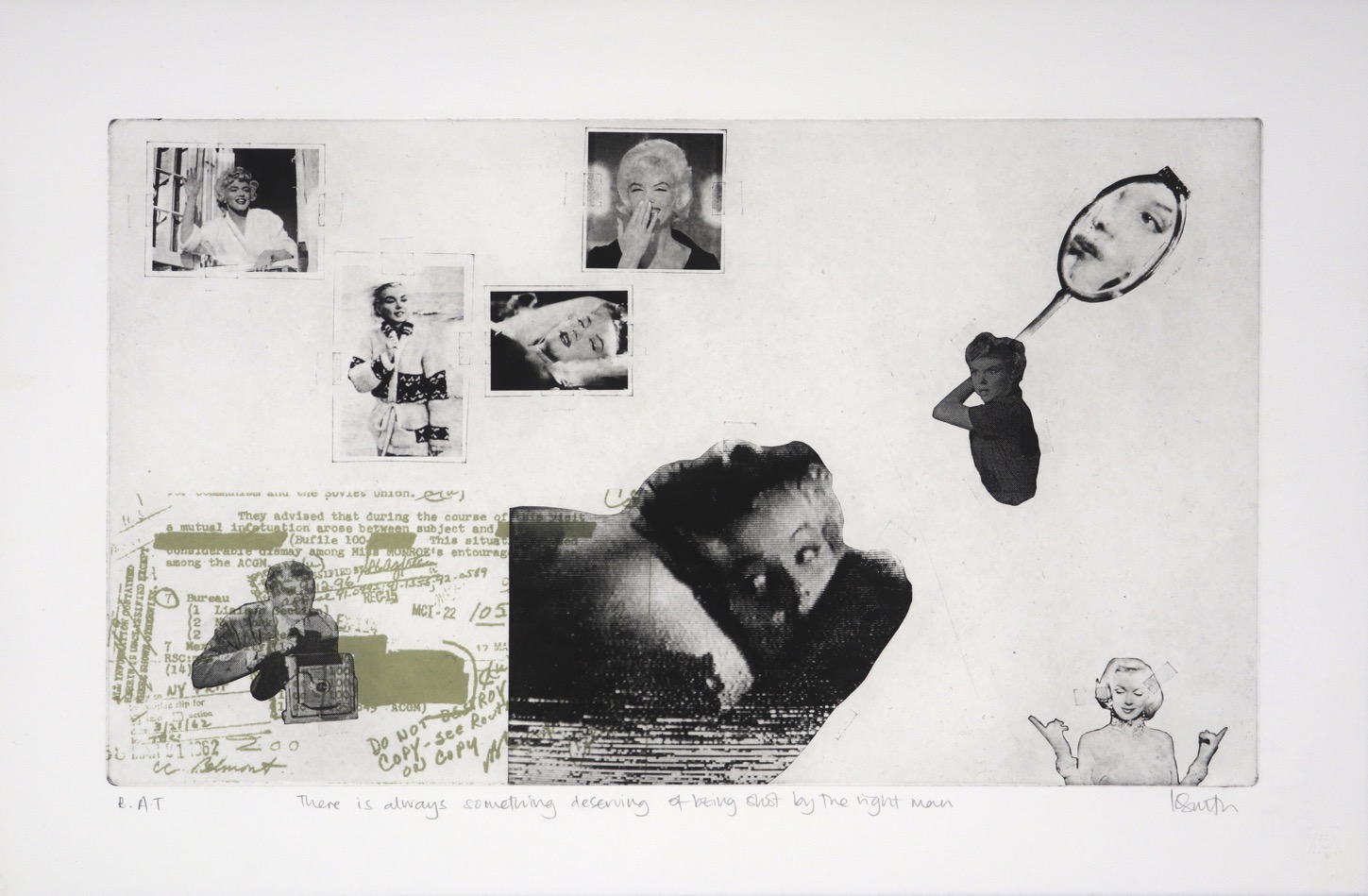
Title: There is always something deserving of being shot by the right man.
Medium: Two colour combination lithograph and gravure print
Paper size: 33 x 50 cm
Image size: 24.5 x 42 cm
Edition size: 10
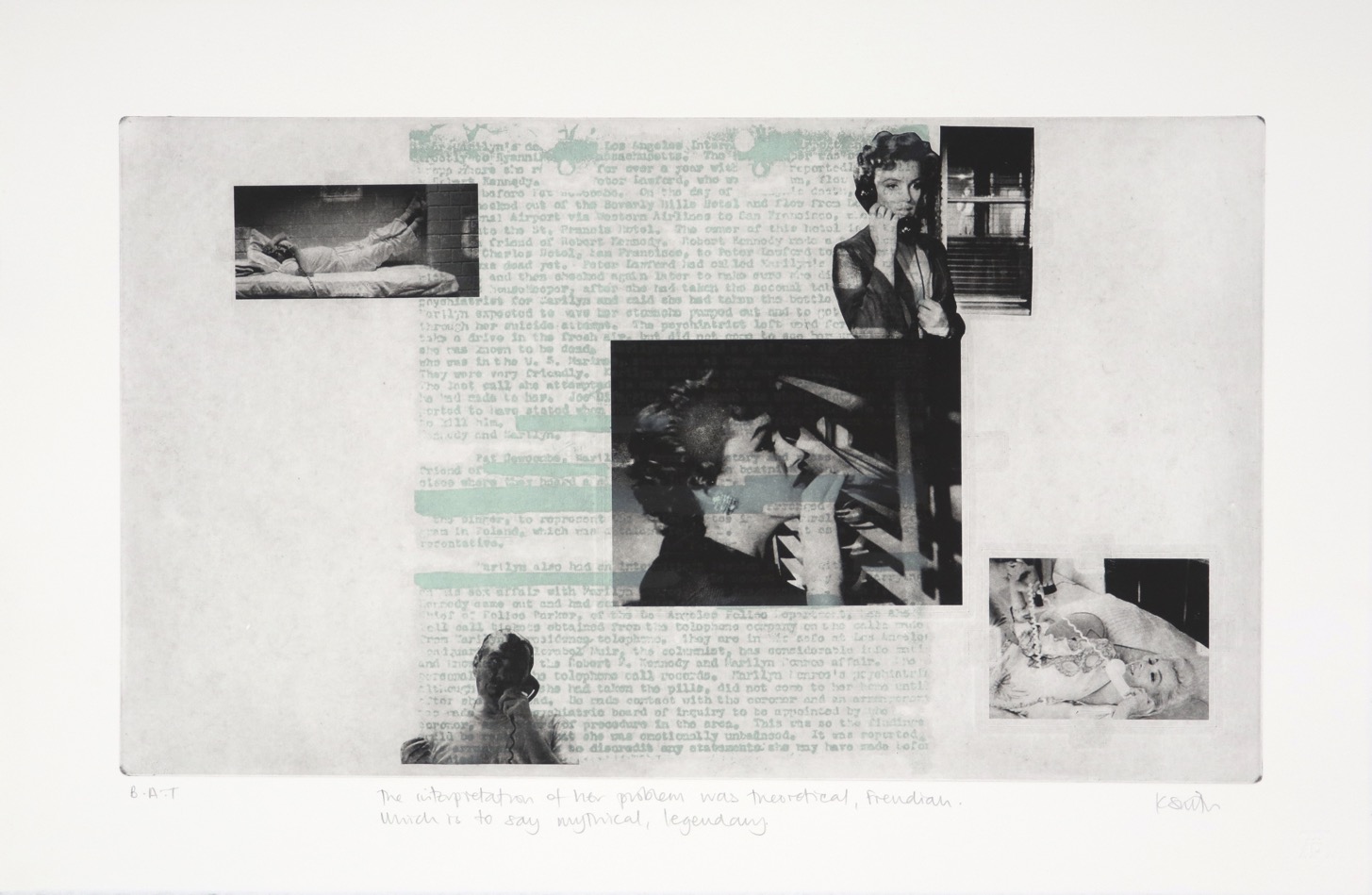
Title: The interpretation of her problem was theoretical, Freudian. Which is to say mythical, legendary.
Medium: Two colour combination lithograph and gravure print
Paper size: 33 x 50 cm
Image size: 24.5 x 42 cm
Edition size: 10
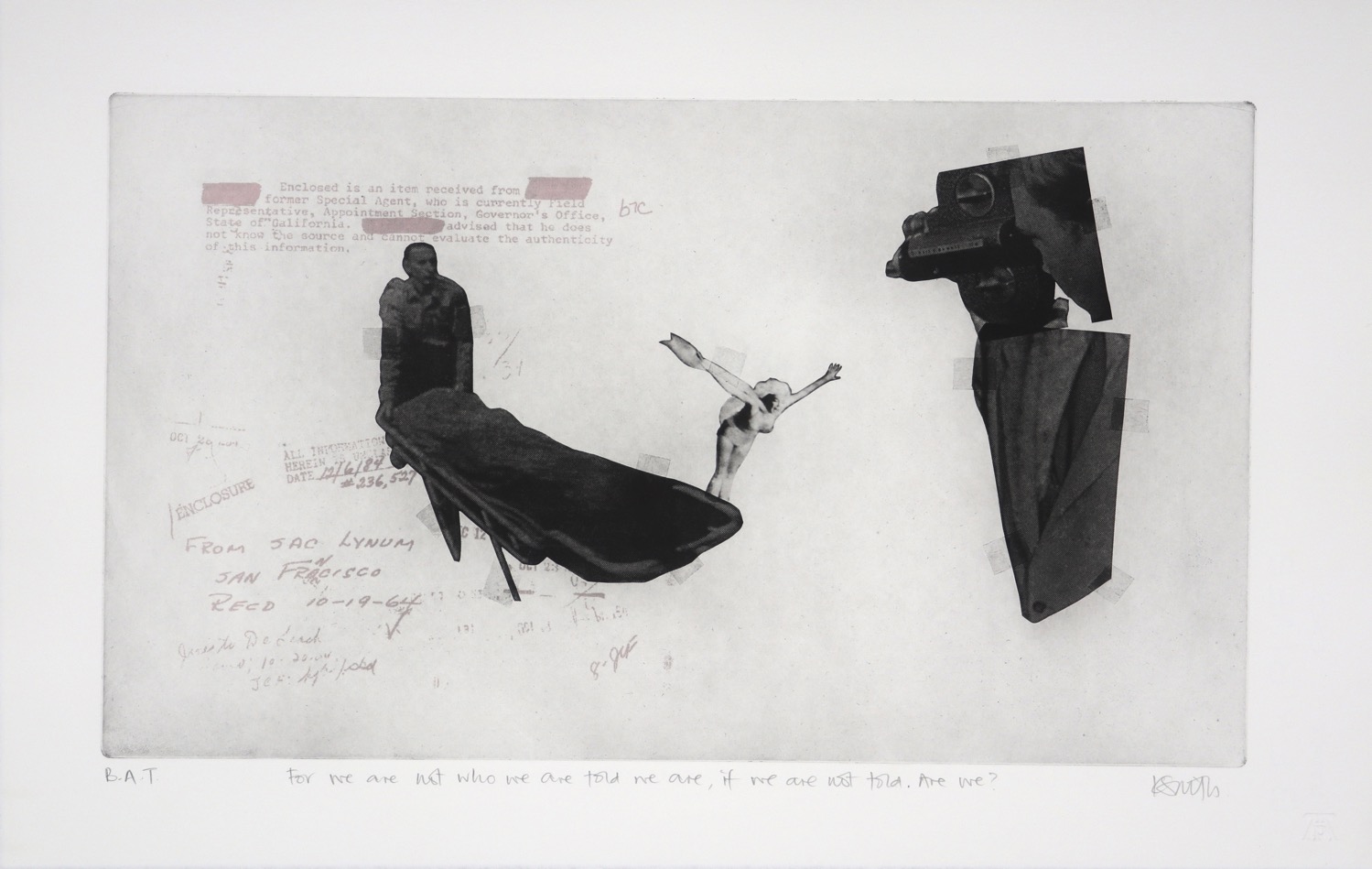
Title: For we are not who we are told we are, if we are not told, Are we?
Medium: Two colour combination lithograph and gravure print
Paper size: 33 x 50 cm
Image size: 24.5 x 42 cm
Edition size: 10
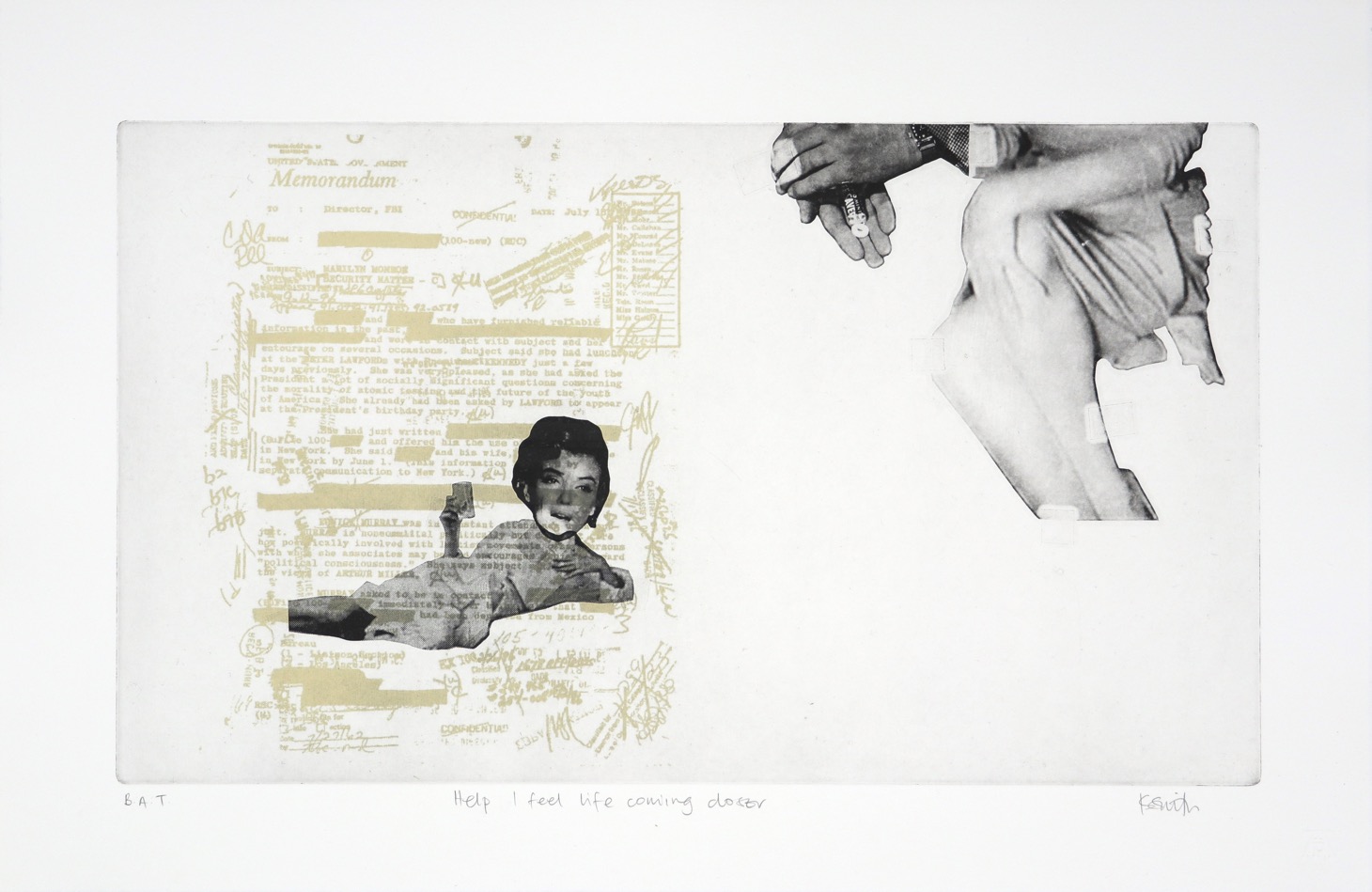
Title: Help, I feel life coming closer.
Medium: Two colour combination lithograph and gravure print
Paper size: 33 x 50 cm
Image size: 24.5 x 42 cm
Edition size: 10
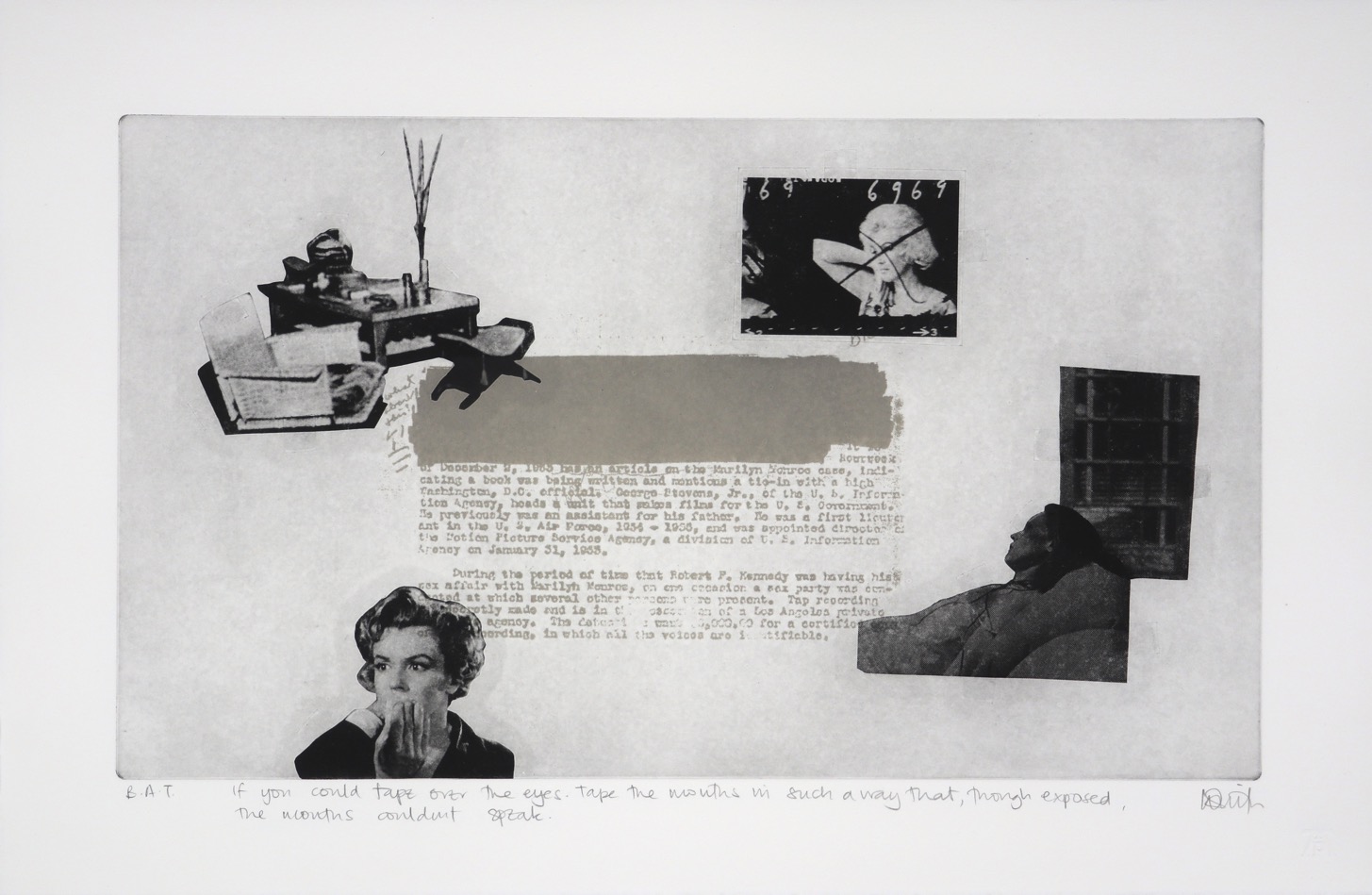
Title: If you could tape over the eyes. Tape the mouths in such a way that, though exposed, the mouths couldn't speak.
Medium: Two colour combination lithograph and gravure print
Paper size: 33 x 50 cm
Image size: 24.5 x 42 cm
Edition size: 10
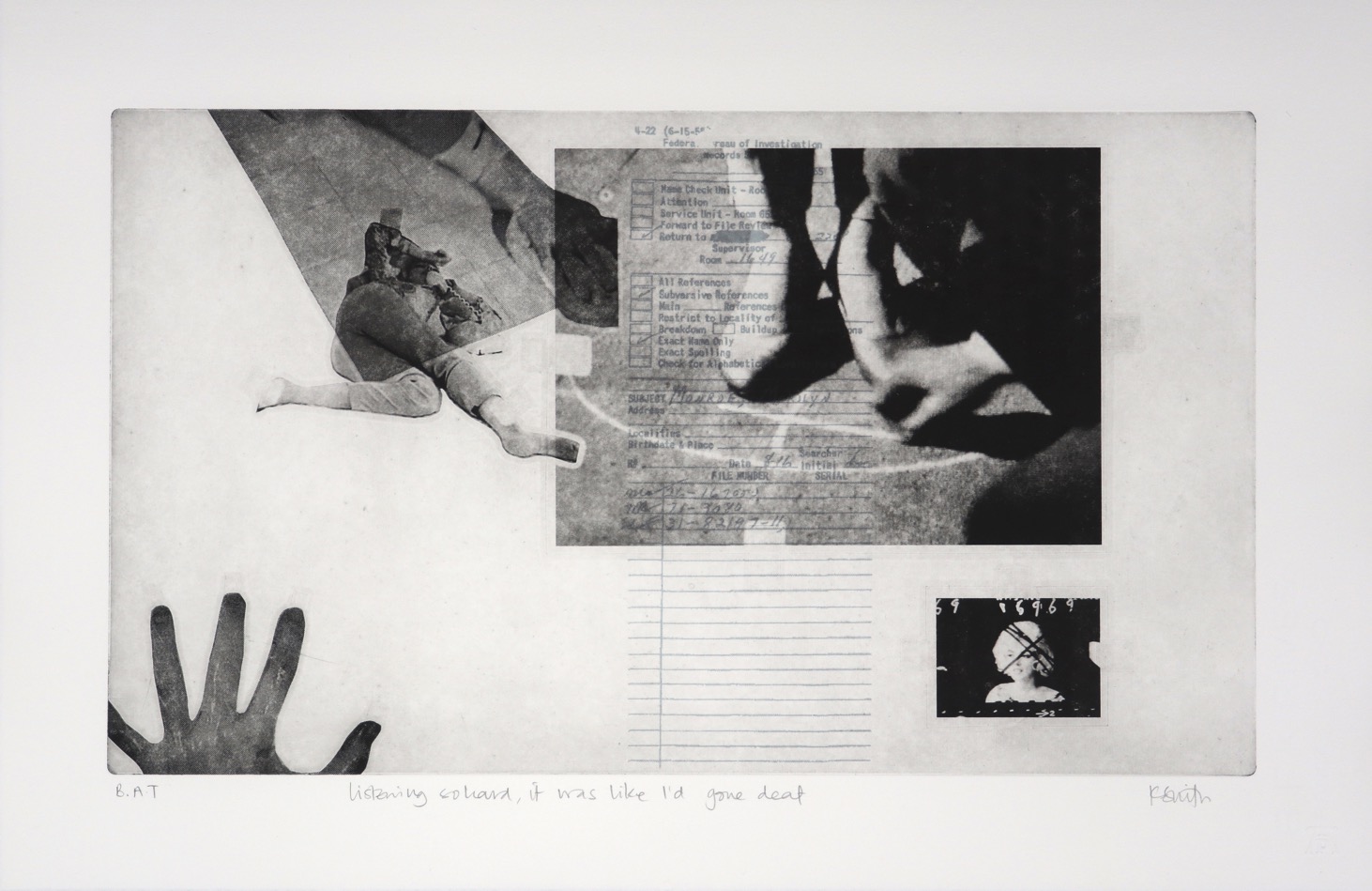
Title: Listening so hard, it was like I'd gone deaf.
Medium: wo colour combination lithograph and gravure print
Paper size: 33 x 50 cm
Image size: 24.5 x 42 cm
Edition size: 10
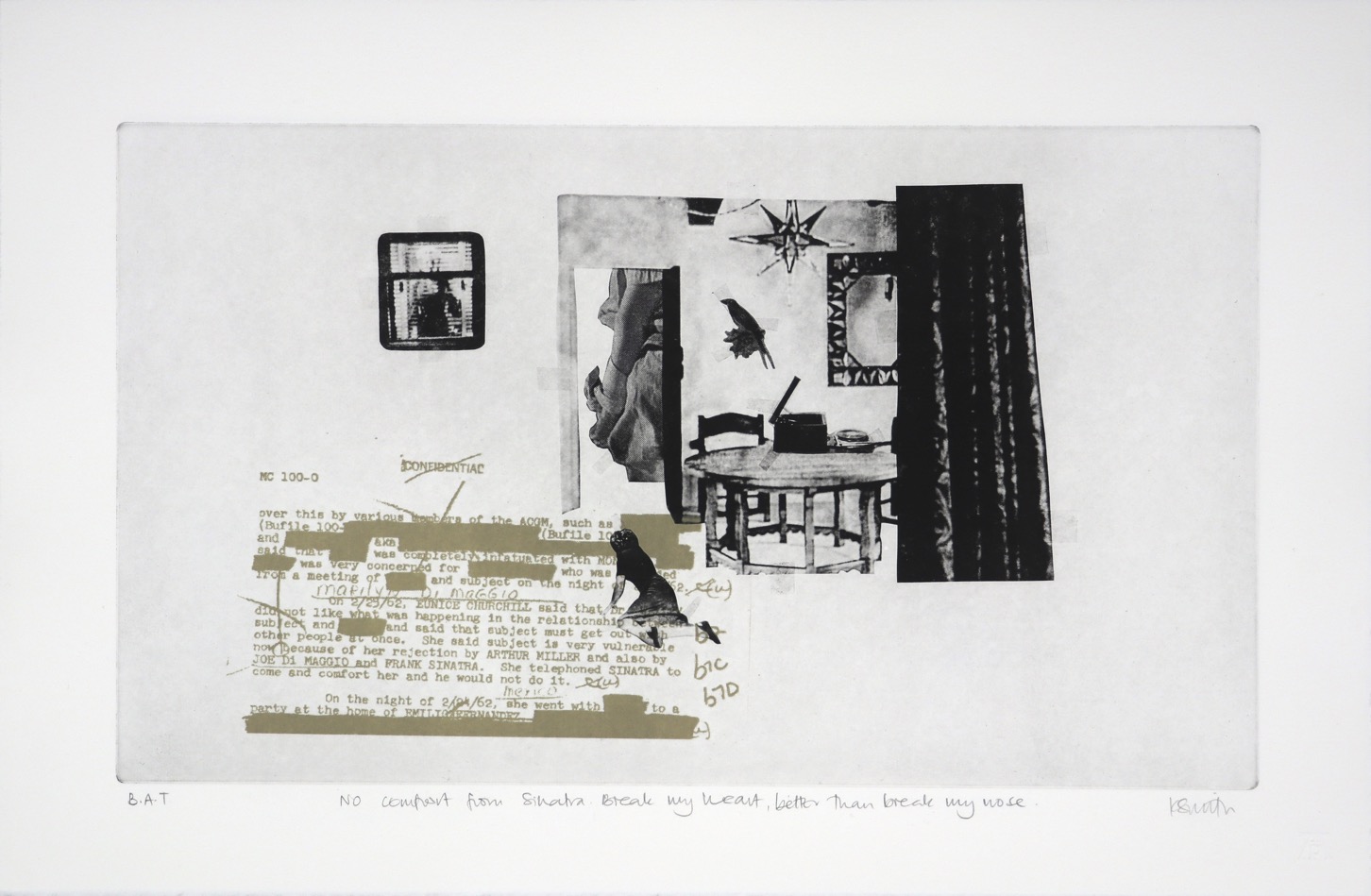
Title: No comfort from Sinatra. Break my heart, better than break my nose.
Medium: Two colour combination lithograph and gravure print
Paper size: 33 x 50 cm
Image size: 24.5 x 42 cm
Edition size: 10
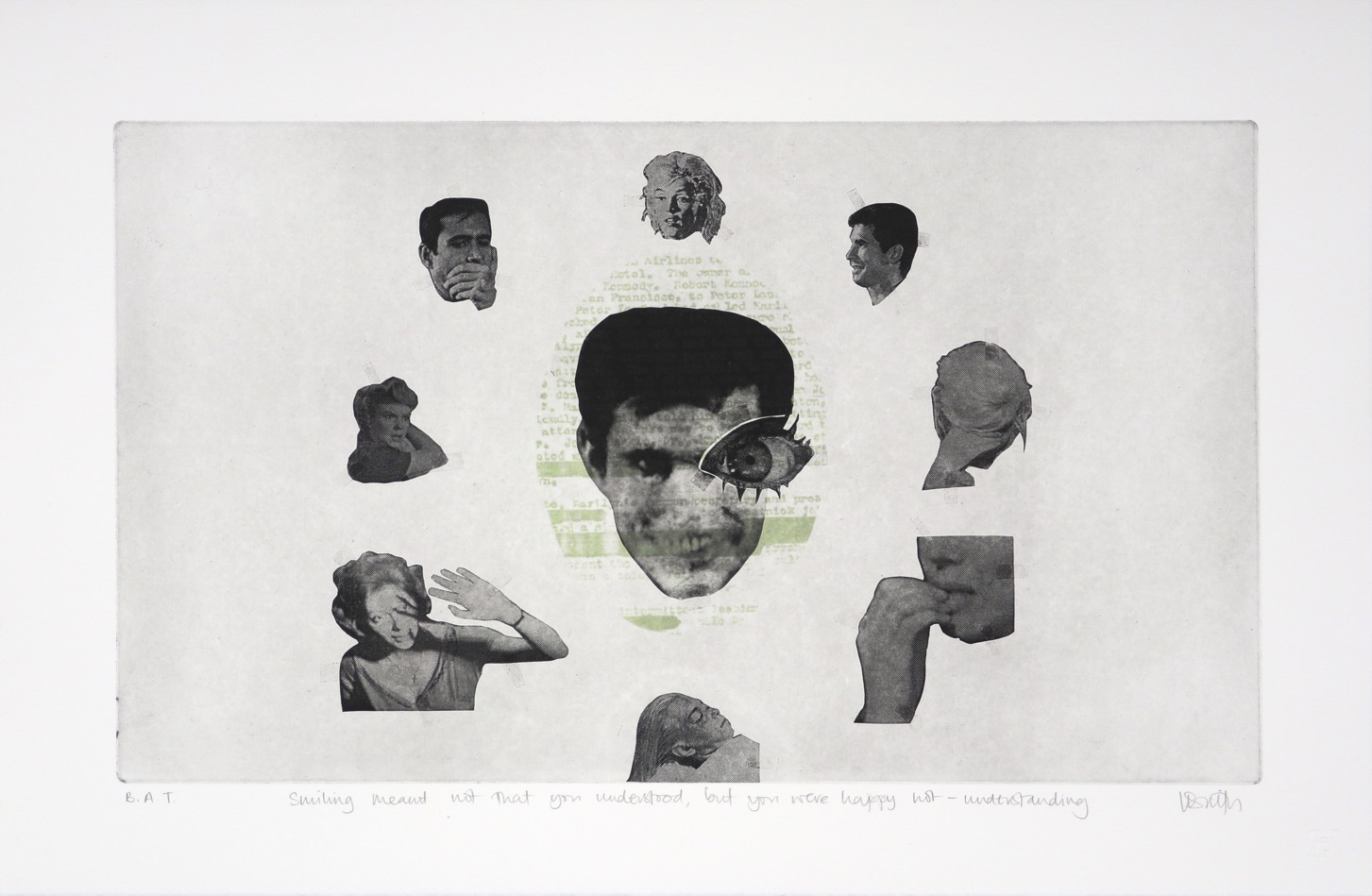
Title: Smiling meant not that you understood, but you were happy not - understanding.
Medium: Two colour combination lithograph and gravure print
Paper size: 33 x 50 cm
Image size: 24.5 x 42 cm
Edition size: 10
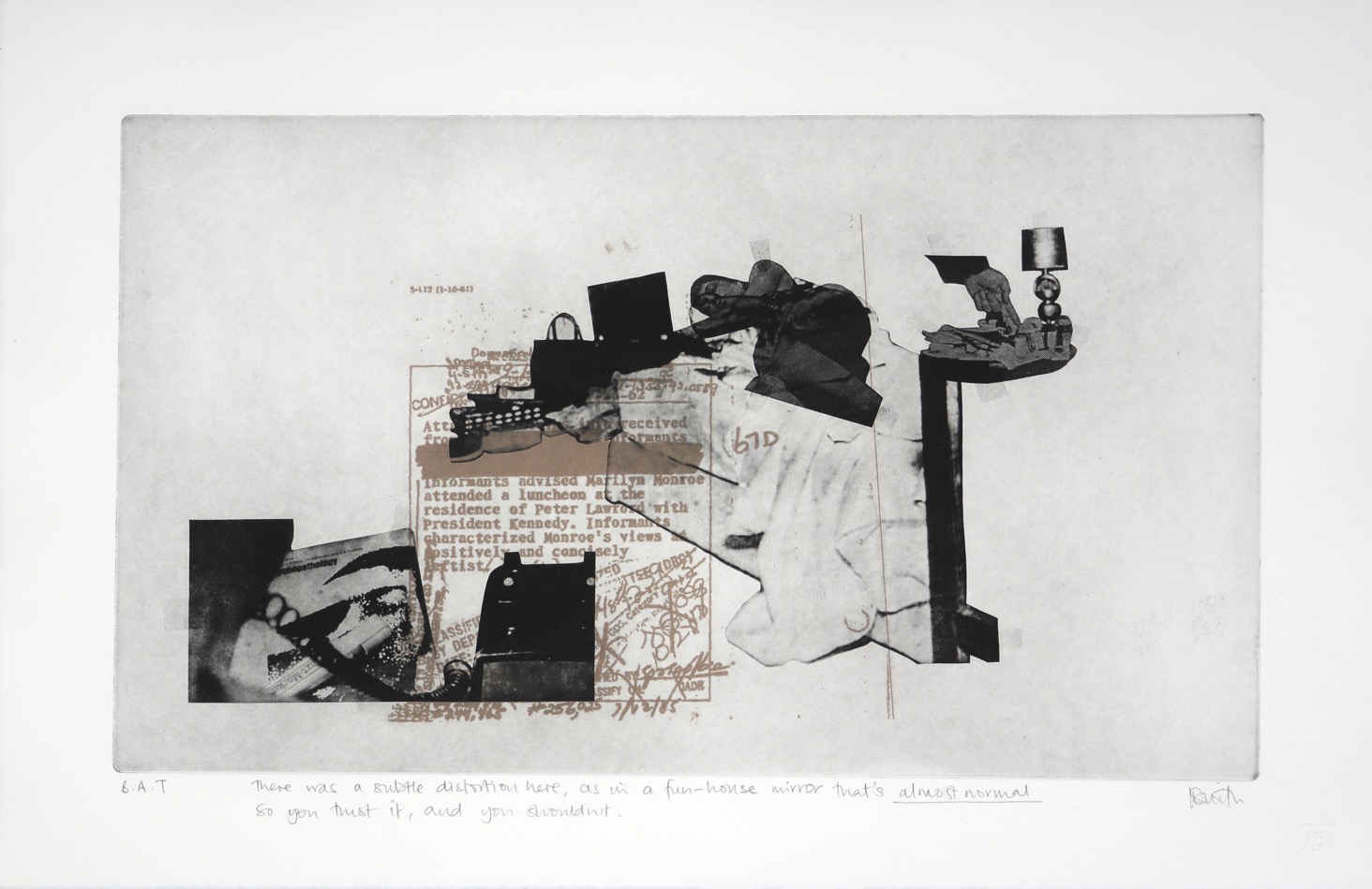
Title: There was a subtle distortion here, as in a fun-house mirror that almost normal, so you trust it and you shouldn't.
Medium: Two colour combination lithograph and gravure print
Paper size: 33 x 50 cm
Image size: 24.5 x 42 cm
Edition size: 10
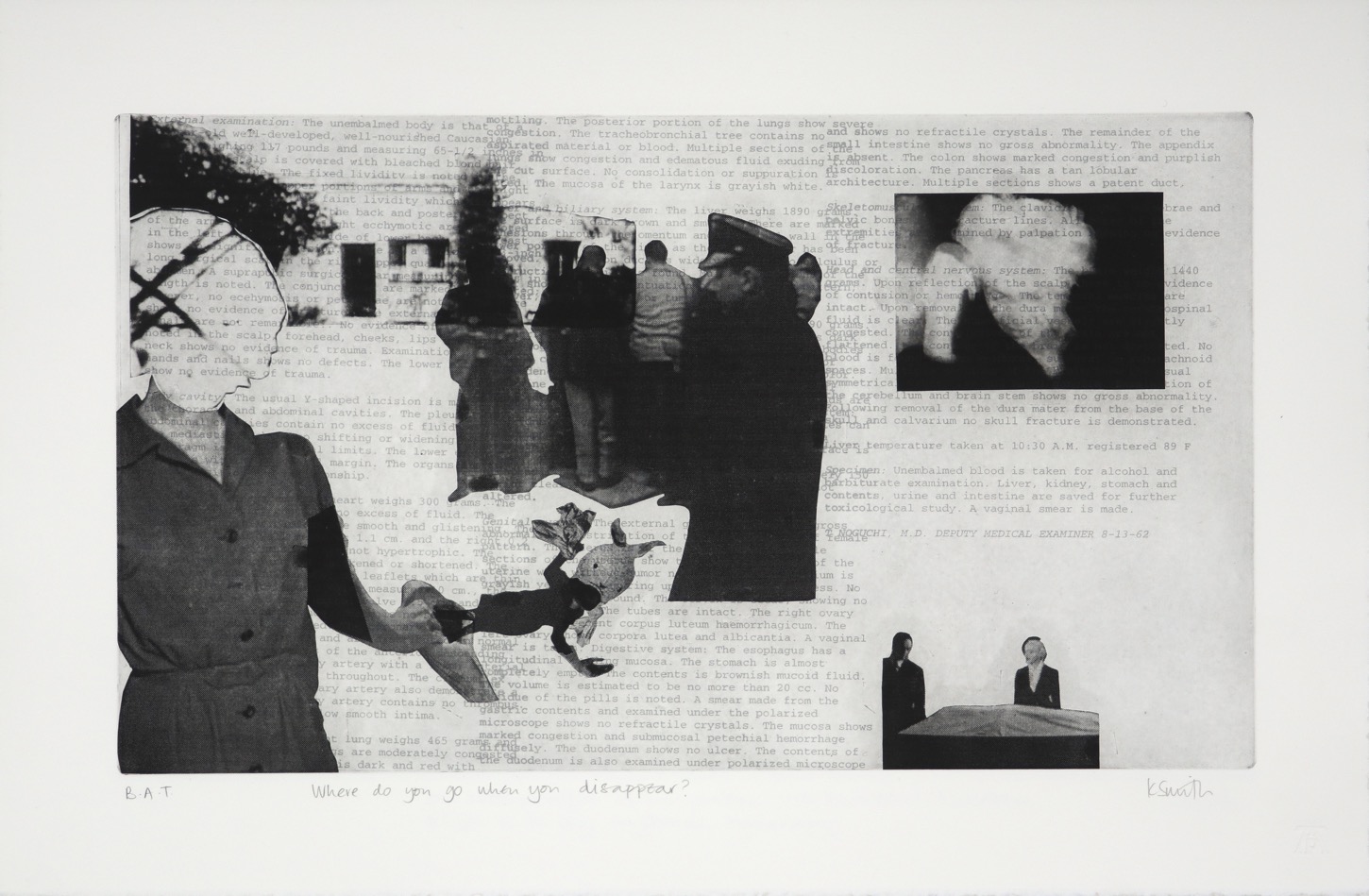
Title: Where do you go when you disappear?
Medium: Two colour combination lithograph and gravure print.
Paper size: 33 x 50 cm
Image size: 24.5 x 42 cm
Edition size: 10
Notes on source material
Peculiar Modern Behaviour, or, don't go away, it gets better
Titles
are paraphrased extracts from Blonde, a fictional biography of Marilyn
Monroe by Joyce Carol Oates (2000, Fourth Estate) and document content
from an FBI dossier on Marilyn Monroe.
Photolitho elements are extracts from FBI dossier on Marilyn Monroe as well as an extract from her autopsy report, 1962.
Police photographs, publicity stills of Marilyn Monro etc credited to documentary The Final Days (dir. Patty Ivins, 2001)
Additional
elements all produced as video grabs shot on mini DVD off screen and
printed out either as stacastic or laser prints on film. Sources listed
below under specific print titles.
1. No comfort from Sinatra. Break my heart better than break my nose. [our ref: no comfort]
Figure in window, crawling woman, girl with hands tied, curtain on right from Don't Bother to Knock (dir. Roy Baker, 1952)
Interior space: Marilyn Monroe's house in Brentwood, California, 1962. Police photograph.
Bird on wall, record player on a table: from Alfred Hitchcock's Psycho (1960).
2.
There was a subtle distortion here, as in a fun-house mirror that's
almost normal so you trust it, and you shouldn't. [our ref: subtle
distortion]
Main source image: Marilyn Monroe's bed photographed
after her body was removed to the morgue for autopsy. Police photograph,
1962.
Figure, phone and book at bottom left from Michael Mann's
Manhunter (1986), which featured the first film representation of Dr
Hannibal Lektor, played by Brian Cox. The spelling of his name was
changed to Lecter in the film version of Thomas Harris' The Silence of
the Lambs, 1990.
Figure on bed: from Henry: Portrait of a Serial Killer (dir. John McNaughton, 1986)
Hand
pointing at pills: a Police photograph of pill bottles on Marilyn
Monroe's bedside table, 1962. Allegedly planted there after her body was
discovered to create the impression of suicide (accidental or
deliberate).
3. If you could tape over the eyes. Tape the mouths in
such a way that, though exposed, the mouths couldn't speak [our ref:
tape the mouths]
furniture top left detail of Marilyn Monroe's lounge, police photograph, 1962.
Bottom left: video grab from Don't Bother to Knock (dir. Roy Baker, 1952)
Top right: Marilyn Monroe outtake/dumped footage from Something's Got to Give (dir. George Cukor, 1962, unfinished)
Bottom
right: French door detail from Marilyn Monroe's house, police
photograph, 1962. The woman on a couch from Henry: Portrait of a Serial
Killer (dir. John McNaughton, 1986).
4. The interpretation of her problem was theoretical, Freudian. Which is to say mythical, legendary. [our ref: mythical]
top and bottom left: Brian Cox as Dr Hannibal Lektor in Manhunter (dir. Michael Mann, 1986)
Top right and centre: Marilyn Monroe as Nell in Don't Bother To Knock (dir. Roy Baker, 1952)
Bottom right: Marilyn Monroe still photograph from The Final Days (dir. Patty Ivins, 2001).
5. Help I feel life coming closer [our ref: life]
reclining
figure: Marilyn Monroe still photograph from The Final Days (dir. Patty
Ivins, 2001). Head from character Nell in Don't Bother to Knock (dir.
Roy Baker, 1952).
Hands holding a roll of lifesavers from Don't Bother to Knock.
Legs top right: Marilyn's legs in press photograph from The Final Days.
6. Listening so hard, it was like I'd gone deaf. [our ref: deaf]
Hand bottom left: Janet Leigh as Marion Crane in Psycho (dir. Alfred Hitchcock, 1960)
Marilyn Monroe on phone. Still photograph from The Final Days (dir. Patty Ivins, 2001)
Hand wiping floor: Anthony Perkins as Norman Bates in Psycho.
Feet with a cross on the floor: Moira Shearer as Vivian in Michael Powell's Peeping Tom (1959).
Bottom right: Marilyn Monroe outtake/dumped footage from Something's Got to Give (dir. George Cukor, 1962, unfinished)
7. There is always something deserving of being shot by the right man. [our ref: the right man]
Marilyn Monroe at window from The Final Days (dir. Patty Ivins, 2001)
. Marilyn Monroe on a beach from The Final Days.
Marilyn Monroe laughing. Outtake from Something's Got to Give (dir. George Cukor, 1962, unfinished)
Marilyn Monroe sideways glance as Rose Loomis in Niagara (dir. Henry Hathaway, 1953)
Man with camera: Carl Boehm as Mark Lewis in Peeping Tom (dir. Michael Powell, 1959)
Main Marilyn Monroe image with static from Niagara.
Face in mirror and Marilyn Monroe taking a swipe as Nell from Don't Bother to Knock (dir. Roy Baker, 1952)
Marilyn Monroe bottom right as Lorelei Lee in Gentlemen Prefer Blondes (dir. Howard Hawks, 1953).
8. Smiling meant not that you understood, but you were happy not-understanding. [our ref: smiling]
middle face: Anthony Perkins as Norman Bates from Psycho (dir. Alfred Hitchcock, 1960)
Eye: close up on Janet Leigh after shower murder scene in Psycho
faces clockwise from top:
1.
Marilyn Monroe outtake from Something's Got to Give (dir. George Cukor,
1962, unfinished) 2. Anthony Perkins as Norman Bates in Psycho (dir.
Alfred Hitchcock, 1960) 3. Marilyn Monroe outtake from Something's Got
to Give. 4. Marilyn Monroe as Nell in Don't Bother to Knock (dir. Roy
Baker, 1952) 5. Marilyn Monroe in a mortuary (police photograph, 1962)
6. Anna Massey as Helen Stephens from Peeping Tom (dir. Michael Powell,
1959) 7. Marilyn Monroe as Nell in Don't Bother to Knock
9. Where do you go when you disappear? [our ref: disappear]
Housetop left: Marilyn Monroe's house in Brentwood, California. Police photograph, 1962
Policemen and journalists gathered outside Marilyn Monroe's house after her body was discovered, 1962
Cross-hatched face: Marilyn Monroe outtake from Something's Got to Give (dir. George Cukor, 1962, unfinished)
Figure: Marilyn Monroe as Nell in Don't Bother to Knock (dir. Roy Baker, 1952)
Arm holding fish: from Henry: Portrait of a Serial Killer (dir. John McNaughton, 1986)
Figure sprawled on floor: Marilyn Monroe as Rose Loomis in Niagara
Rabbit head and left arm from Psycho (dir. Alfred Hitchcock, 1960)
Top right: dishevelled Marilyn Monroe from The Final Days (dir. Patty Ivins, 2001)
Bottom right: Marilyn Monroe as Rose Loomis identifying her lover's body in Niagara (dir. Henry Hathaway, 1953)
10. For we are not who we are told we are if we are not told. Are we? [our ref: who we are]
Policeman
wheels Marilyn Monroe's shrouded body from her house, 1962 Publicity
shot of Marilyn Monroe in the sea from The Final Days (dir. Patty Ivins,
2001)
Face with camera: Carl Boehm as Mark Lewis in Peeping Tom (dir. Michael Powell, 1959)
Suit and tie: Richard Widmark as Jed Towers from Don't Bother to Knock (dir. Roy Baker, 1952)
Follow Kathryn Smith on Instagram


